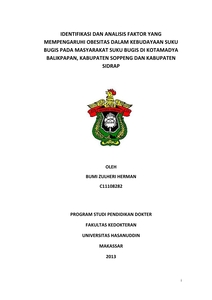HERMAN, BUMI ZULHERI (2013) IDENTIFIKASI DAN ANALISIS FAKTOR YANG MEMPENGARUHI OBESITAS DALAM KEBUDAYAAN SUKU BUGIS PADA MASYARAKAT SUKU BUGIS DI KOTAMADYA BALIKPAPAN, KABUPATEN SOPPENG DAN KABUPATEN SIDRAP. Skripsi thesis, Universitas Hasanuddin.
![[thumbnail of Cover]](/8003/1.hassmallThumbnailVersion/bumizulher-949-1-13-bumi-2%20COVER1.jpg)

bumizulher-949-1-13-bumi-2 COVER1.jpg
Download (266kB) | Preview
bumizulher-949-1-13-bumi-2 1-2.pdf
Download (484kB)
bumizulher-949-1-13-bumi-2 DAPUS-LAM.pdf
Download (224kB)
bumizulher-949-1-13-bumi-2.pdf
Restricted to Registered users only
Download (1MB)
Abstract (Abstrak)
SUMMARY
Hasanuddin University
Faculty of Medicine
General Physician
Bumi Zulheri Herman
Identification and Analysis of Obesity Factor in Bugis Culture in Bugis
Population of Balikpapan, Soppeng and Sidrap.
(xi + 50 pages + 36 Tables)
Obesity is a worldwide health problem. People with obesity tend to have
bigger risk suffer from non communicable diseases such as hypertension, stroke,
diabetes mellitus and eventually death. Epidemic trend shows a increase 2 times
fold of obesity prevalence in last two decades. Some of important risk factors has
been identified and cultural factor may play important role in increasing tendency
of obesity in several ethnic. Sulawesi ethnics consist of Bugis, Makassar, Mandar
and Toraja and have different ways of life according to the culture. This research
was conducted to identify and analyze cultural factor that might affect the
existence of obesity in Buginese. This case control study involved 96 people from
3 different region, Balikpapan(A), Soppeng(B) and Sidrap(C) which represent
different characters of buginese, the local buginese and buginese who live outside
Sulawesi. Sample were collected using random sampling and classified into obese
and non obese group and and asked for several information including food intake,
economy costs, job, Perspective of culture including Siri for protecting women
(which may cause women have less activities and no possibility to be
breadwinner) and Siri of Body (feel ashame with obesity). Style of house and
topography of environment were interpreted by surveyor. Antropometric data also
obtained from sample. Corelation analysis was conducted using Spearman and
Cooficient Contingency test, and comparative analysis by using Kruskal Wallis
test. From three region,there are no correlation between style of house (A p=0,984
B p=0,056 C p=0,331), topography (A p=0,727 B p=0,632 C p=0,151), and job (A
p=0,706 B p=0,632 C p=0,160) to obesity. Food intake is strongly correlate with
obesity (A:p=0,000 r=0,628. B:p=0,000 r=0,633. C:p=0,012 r=0,455). In this
study, economy status in Soppeng has a strong correlation with obesity(p=0,001
r=0,537) further analysis revealed that the higher economy status, the house will
be more luxurious (p=0,000 r=0,633 – 0,824). So style of house will correlate
indirectly to obesity. This might explain style of house is almost correlate with
obesity in Soppeng (p=0,056). There are no significant difference between siri
that might limit the participation of women become breadwinner and obesity (A
p=0,534 B p=0,529 C p 0,982). And the same with Siri of body (A p=0,417 C
p=0,498), except in Soppeng (p=0,014).
| Item Type: | Thesis (Skripsi) |
|---|---|
| Subjects: | R Medicine > R Medicine (General) R Medicine > RA Public aspects of medicine |
| Depositing User: | - Nurhasnah |
| Date Deposited: | 21 Oct 2021 01:01 |
| Last Modified: | 21 Oct 2021 01:01 |
| URI: | http://repository.unhas.ac.id:443/id/eprint/8003 |


